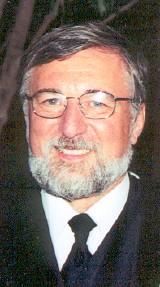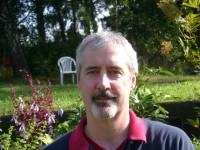2006 Haagen-Smit Prize Winners
The Executive Editors and the Publisher of Atmospheric Environment take great pleasure in announcing the sixth ''Haagen-Smit Prize'', designed to recognize outstanding papers published in Atmospheric Environment. The Prize is named in honor of Prof. Arie Jan Haagen-Smit, a pioneer in the field of air pollution and one of the first editors of the International Journal of Air Pollution, a predecessor to Atmospheric Environment.
The ''Haagen-Smit Prize'' is given annually to two papers previously published in Atmospheric Environment and covering different science areas. Additional information about this award and the selection committee members can be found at https://earthscience.arc.nasa.gov/singh/. The nominating letters printed below describe the two 2006 winning papers.
Nomination Letters
 Wesely, M. L., Parameterization of Surface Resistances to Gaseous Dry Deposition in Regional-Scale Numerical-Models. Atmospheric Environment, 23(6), 1293-1304, 1989.
Wesely, M. L., Parameterization of Surface Resistances to Gaseous Dry Deposition in Regional-Scale Numerical-Models. Atmospheric Environment, 23(6), 1293-1304, 1989.
We would like to nominate for the Atmospheric Environment's Haagen-Smit Prize the above paper by the late Dr. Marvin L. Wesely. Published in 1989, this paper presents parameterizations that provide realistic estimates for the dry deposition of key gaseous air pollutants. The methods first set out in this seminal study are now almost universally used by chemical transport modelers to represent atmosphere-surface exchange of gases and the dry deposition of particles.
Specifically, this paper presents a physically based parameterization of surface resistances to dry deposition of gases to land surfaces such as vegetation, water, and snow that replaces lookup tables that had previously been used in modeling this deposition. The physical basis of the parameterization explicitly takes into account micrometeorological characteristics of the atmosphere-surface interaction and the nature of the surface, including physical (solubility) and chemical interactions of the particular gas with the particular surface material. Building on Dr. Wesely's extensive prior micrometeorological research as well as the research of many others, the paper uses a flux matching technique to represent the transport and deposition of gases to the surface through the now familiar series and parallel resistor network that takes into account vegetation, the lower canopy, and the ground. The approach introduces methods for explicitly treating surface moisture through the solubility and reactivity of the gaseous constituents, which has allowed it to be extended to numerous gases beyond those initially examined. Surface vegetative properties, categorized according to 11 land use types and 5 seasonal categories, have also been extended by subsequent investigators to other situations of interest beyond the several types of temperate vegetation that were explicitly treated in the paper.
The dry-deposition scheme presented in this paper is now almost universally used in models of atmospheric chemistry transport and deposition. Models such as the Regional Acid Deposition Model (RADM), that was the initial focus for the development of the parameterization, were later adopted by STEM-II and other regional scale chemical transport models (CTMs). The latest realization of the RADM model in the form of the CMAQ model implements the Wesely scheme for dry deposition. The emergence of global scale 3-D CTMs in the 90's has seen the parameterization now being applied to global scale problems. This necessitated some extensions of the initial landuse categories, some of which were introduced by Wesely himself in later publications. Global scale models such as MOZART have implemented the scheme, and other models such as GMI and GOES-CHEM have incorporated versions of the initial scheme again modified mainly in terms of the land-use categories, the latter greatly extended by use of satellite data sets.
The broad and continuing influence of the paper can be found in the numerous publications that cite it, some 340 citations to date (mid 2005). But perhaps an even greater appreciation of the influence of the paper can be found in the fact that in 2004, the last full year for which citation information is available and some 15 years after it was published, the paper was cited by some 56 publications. Clearly this is a paper of remarkable lasting value.
By any standards Wesely's paper has been a landmark paper in Atmospheric Environment, eminently fulfilling the criterion for the Haagen-Smit Prize of "papers that have had a significant impact in their field." Sadly Marv Wesely died at the age of 58 in January, 2003, from a rare form of heart cancer. Award of the Haagen-Smit Prize for this paper would not only be fitting on the strengths of this paper itself but would additionally be an excellent way for Marv Wesely to be remembered and honored for his many contributions to atmospheric science.
Nominators: Jeffrey S. Gaffney, University of Arkansas, USA; Stephen E. Schwartz, Brookhaven National Laboratory, USA

 A. D. Clarke and K. J. Noone, Soot in Arctic Snow: A Cause for Perturbations of Radiative Transfer, Atmospheric Environment, 19(12), 2045-2053, 1985.
A. D. Clarke and K. J. Noone, Soot in Arctic Snow: A Cause for Perturbations of Radiative Transfer, Atmospheric Environment, 19(12), 2045-2053, 1985.
It gives me great pleasure to nominate the above 1985 paper by A, D. Clarke and K. J. Noone for the 2006 Haagen-Smit Prize. Published inAtmospheric Environment over two decades ago, this was the first paper to draw attention to the role of Black Carbon in anthropogenic aerosol and its potential contribution to radiative forcing through changing snow albedo. In the early 1980’s there was emerging recognition that anthropogenic aerosol optical properties could have potentially regional or possibly global effects. It was in this context that Tony Clarke questioned and investigated the fate of this aerosol and the potential impact that Black Carbon (soot) might have on snow albedo and ultimately regional Arctic climate.
The work involved a careful collaborative effort to collect samples from the North American and European Arctic. These were shipped back frozen for spectral absorption analysis that isolated the contributions of soot and dust. Coupled with the radiative transfer modeling of Steven Warren, the result was the first assessment of the radiative impact of soot delivered to the Arctic snowpack and one of the first efforts to employ the concept of radiative forcing to quantify the potential climatic effect of this constituent. The paper demonstrated that a significant decrease in seasonal snow albedo could be expected from Black Carbon concentrations present in Arctic snow during the early 1980’s. The resulting forcing was positive over the season and about equal to the atmospheric forcing of seasonal Arctic Haze and additive to it. This paper identified, characterized and estimated the impact of soot in snow and recognized the potential feedback caused by accelerated snowmelt upon surface albedo.
Current concern over increasing anthropogenic sources of Black Carbon and related climate forcing has now caught up with this paper that drew attention to this issue “ahead of its time”. The Clarke and Noone data set remains the most extensive to date and has been recognized as the “classic study” by Dr. James Hansen, a pioneer in climate studies [Hansen, J. and L. Nazarenko, "Soot Climate Forcing via Snow and Ice Albedos", Proceedings of the National Academy of Sciences, 101, 2, 423-428, 2004], and these observations continue to provide a critical contribution to current models. A follow up paper by this group [Noone, K. J., A. D. Clarke, "Soot Scavenging Measurements for Arctic Snowfall",Atmospheric Environment, 22 (12), 2773, 1988] demonstrated consistent scavenging ratios of soot to snow over a wide range of atmospheric concentrations and provide a tool for models to estimate soot uptake into the Arctic snowpack. These pioneering studies continue to be a benchmark for gauging these effects. The two papers by Clarke and Noone have over 80 citations, most of these in the last 5 years when the potential radiative effects of Black Carbon in snow were “rediscovered” and are now being estimated with more contemporary and complex climate models.
Professor Anthony Clarke has a consistent record of outstanding scientific research with many of his publications appearing in Atmospheric Environment. I believe that the subject paper and its authors make an excellent choice for the Haagen-Smit Prize.
Nominator: Hanwant B. Singh, NASA Ames Research Center, USA
Prof. Anthony Clarke, University of Hawaii, Honolulu, HI, USA (tclarke@soest.hawaii.edu)
Our congratulations go to the authors of the two outstanding papers selected for the 2006 Prize. We would also very much like to thank all the nominators for their effort and note that unsuccessful nominations are eligible for consideration again next year. We further take this opportunity to acknowledge the conscientious effort of the selection committee, made up of members from five countries, in arriving at a clear and timely decision.
Hanwant B. Singh and Peter Brimblecombe,
Executive Editors of Atmospheric Environment.
F. Veenstra and K-L. Thonus,
Publishers, Elsevier.
